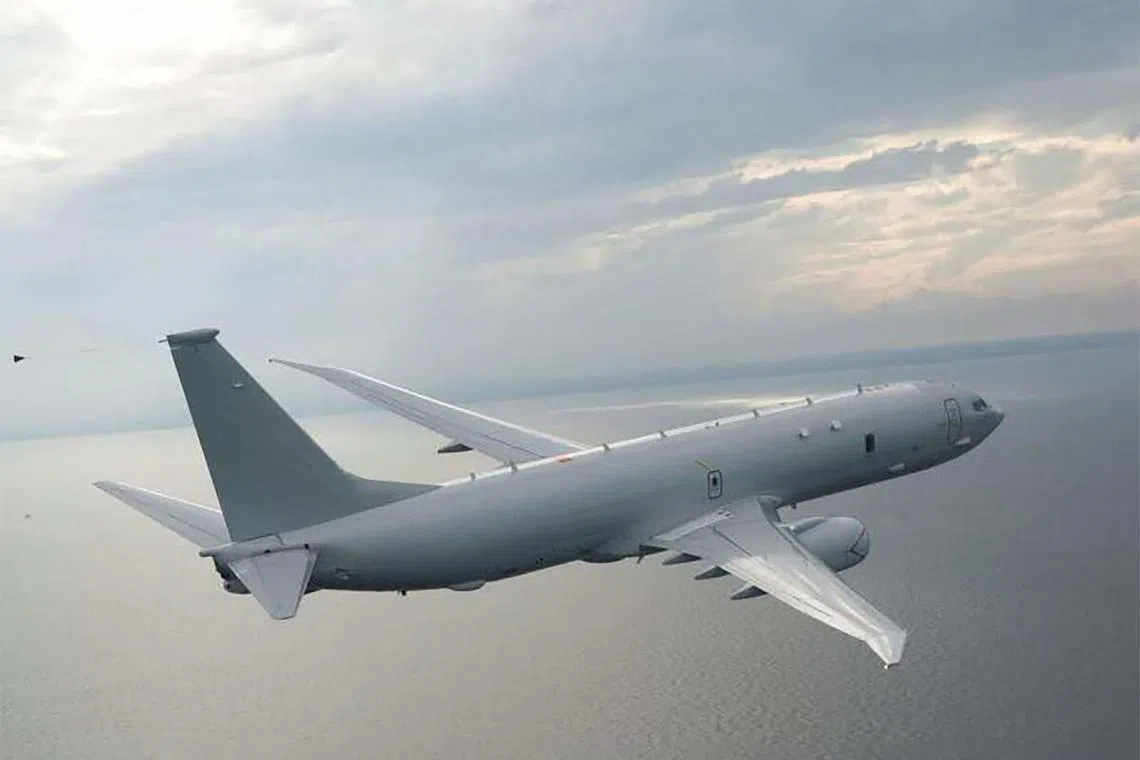New P-8A aircraft plugs anti-submarine gap, signals S’pore’s continued defence ties with US: Experts
Sign up now: Get ST's newsletters delivered to your inbox

The new planes are a significant upgrade over the nine Fokker 50s that the SAF has deployed since 1993.
PHOTO: BOEING
Follow topic:
SINGAPORE – Singapore’s acquisition of four new Boeing P-8A maritime patrol aircraft will upgrade the SAF’s ability to counter submarines amid an increased use of the undersea vessels in recent years, said defence experts.
They said the new planes are a significant upgrade over the nine Fokker 50s that the Singapore Armed Forces has deployed since 1993. The Fokker planes are limited to surveillance of the ocean’s surface and missions targeting ships.
Defence Minister Chan Chun Sing told US Secretary of War Pete Hegseth that Singapore had decided to acquire the Boeing aircraft at a meeting at the Pentagon on Sept 10 (Singapore time).
Mr Chan’s update comes about half a year after his predecessor, Dr Ng Eng Hen, said the Republic was evaluating replacements for the Fokker 50s.
S. Rajaratnam School of International Studies associate research fellow Thomas Lim said a maritime patrol aircraft is meant to surveil a state’s maritime territory and borders as well as monitor threats coming from “above the sea, on the sea and below the sea”.
As a maritime nation, Singapore depends heavily on the security of its sea lines of communication – global trading routes that ships pass through, said Dr Abdul Rahman Yaacob, a South-east Asian defence researcher based at the Australian National University.
Equipped to carry torpedoes, the P-8A enables the Republic of Singapore Air Force (RSAF) to counter submarines, he said.
He added: “As regional countries continue to expand and modernise their naval forces – including the development of submarine fleets – it becomes increasingly important for the RSAF to possess credible anti-submarine warfare capabilities. The acquisition of the P-8A directly addresses this operational gap.”
Mr Chen Chuanren, senior editor at defence, aviation and aerospace publication Aviation Week Network, said the key advantage of the P-8A is its ability to “fuse data” from its on-board sensors to detect and track both surface ships and submarines.
It can also coordinate with naval assets to orchestrate complex missions, functioning as a flying maritime command post with strike capabilities, he said.
Derived from the commercial Boeing 737 airframe, the P-8A offers significant space to carry a wide range of payloads, including anti-ship missiles, sonobuoys (small sonars which detect submarines), torpedoes and electronic warfare systems, he said.
The American-made planes, which have a wingspan of 37.64m and a length of 39.5m, were chosen over at least one other option: the Spanish-developed Airbus C295.
In March, then Defence Minister Ng named the two models as options his ministry was evaluating.
Dr Rahman said while both models share similarities, such as carrying torpedoes and anti-ship missiles, the P-8A holds a “clear advantage” in terms of its longer range and ability to fly at low altitudes.
But performance metrics are rarely the only driver behind the selection of such platforms, Dr Rahman added.
The Defence Ministry’s decision most likely reflects broader strategic considerations to not only enhance operational readiness but also signal a close defence partnership with the United States, he said.
“This could be particularly relevant under the Trump administration, which has consistently urged allies and partners to shoulder more of the defence burden.”
Mr Hegseth had in May urged America’s Asian allies to bump up defence spending to 5 per cent of their gross domestic product (GDP).
Over the last few years, defence spending has hovered around 3 per cent of Singapore’s GDP.
A large proportion of the P-8A’s current users are also key players in the region or close partners with Singapore, noted Mr Lim.
They include fellow Five Power Defence Arrangements member states such as Britain, Australia and New Zealand.
Singapore is part of this grouping, which conducts regular exercises together.
Singapore’s acquisition of the P-8As will lead to increased interoperability with these militaries, referring to their ability to work together, and also generate more opportunity for the exchange of best practices, Mr Lim said.
Prices of the planes vary from customer to customer, and the amount that Singapore will pay for the planes will most likely be revealed only in a congressional notice of US foreign military sales, Mr Chen said.
He noted that New Zealand paid US$1.6 billion (S$2 billion) for four such planes in 2018, but Singapore is expected to get a more advanced version, and will most likely have different logistical and operational requirements for it.
The acquisition is also a “key piece” of the SAF’s transformation, leading to its goal of becoming a fully networked fighting force by 2040, Mr Lim said.
While RSAF assets such as fighters and airborne early-warning aircraft have already reached a high level of integration, the P-8A will fill a critical gap in the maritime domain, Mr Chen said.
“It will strengthen the synergy between air and sea components, allowing Singapore to build a more cohesive, multi-domain warfighting network.”


